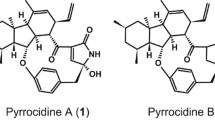Abstract
Calothrixin A is a bioactive metabolite of the cyanobacterium Calothrix and has been shown to be active at nanomolar concentrations against human HeLa cancer cells. It induces apoptotic killing of human Jurkat cancer cells in a time- and concentration-dependent manner, as revealed by flow cytometry, morphological evidence from electron microscopy and DNA fragmentation. It also causes G2/M cell cycle arrest, which is indicative of intracellular DNA damage. It was shown to be redox-active, as measured by oxygen uptake in the presence of dithiothreitol, and caused cleavage of plasmid DNA, as revealed by electrophoresis. This cleavage was blocked by the H2O2 scavenger catalase, but not by other scavengers of reactive oxygen species (ROS). Calothrixin A appeared to induce intracellular formation of ROS as measured by fluorescence of dichlorodihydrofluorescein diacetate. Conditions were not found, however, under which the calothrixin A-induced apoptosis could be reversed by the scavengers, or by the metal chelator desferal. Menadione was compared with calothrixin A. The IC50 at which this compound caused apoptosis was significantly higher. It also induced cell cycle arrest at higher concentrations, although caused plasmid DNA cleavage at lower concentrations. It is postulated that the greater effectiveness of calothrixin A in killing cells is related to its ring structure, which has the characteristics of a DNA intercalator, thereby localizing its quinone-dependent effects.
Similar content being viewed by others
References
Bolton J.L., Trush M.A., Penning T.M., Dryhurst G. and Monks T.J. 2000. Role of quinones in toxicology. Chem. Res. Toxicol. 13: 135-160.
Borowitzka M.A. 1995. Microalgae as sources of pharmaceutical and other biologically active compounds. J. appl. Phycol. 7: 3-15.
Cutts S.M., Masta A., Panousis C., Parsons P.G., Sturm R.A. and Phillips D.R. 1997. A gel mobility shift assay for probing the effect of drug-DNA adducts on DNA-binding proteins. Meth. Mol. Biol. 90: 95-106.
Darzynkiewicz Z. and Li X. 1996. Measurement of cell death by flow cytometry. In: Cotter T.G. and Martin S.J. (eds), Techniques in Apoptosis. A User's Guide. Portland Press, London, pp. 71-106.
Davies D. and Schmid I. 2000. Detecting Apoptosis. In: Diamond R.A. and Demaggiopp S. (eds), Living Colour: Protocols in Flow Cytometry and Cell Sorting. Springer Laboratory Manual, Berlin, pp. 377-384.
Doan N.T., Stewart P.R. and Smith G.D. 2001. Inhibition of bacterial RNA polymerase by the cyanobacterial metabolites 12-epi-hapalindole E isonitrile and calothrixin A. FEMS microbiol. Letts. 196: 135-139.
Gant T.W., Rao D.N., Mason R.P. and Cohen G.M. 1988. Redox cycling and sulphydryl arylation; their relative importance in the mechanism of quinone cytotoxicity to isolated hepatocytes. Chem. Biol. Interact. 65: 157-173.
Jamison M., Gilloteaux J., Venugopal M., Koch J.A., Sowick C., Shah R. and Summers J.L. 1996. Flow cytometric and ultrastructural aspects of the synergistic antitumor activity of vitamin C-vitamin K3 combinations against human prostatic carcinoma cells. Tissue Cell 28: 687-701.
Johnson T.M., Yu Z.X., Ferrans V.J., Lowenstein R.A. and Finkel T. 1996. Reactive oxygen species are downstream mediators of p53-dependent apoptosis. Proc. natl. Acad. Sci. USA 93: 11848-11852.
Kerr J.F.R., Gobe G.C., Winterford C.M. and Harmon B. 1995. Anatomical methods in Cell Death. In: Schwartz L.M. and Osborne B.A. (eds), Methods in Cell Biology - Cell Death 46. Academic Press, San Diego, pp. 1-26.
Maciel E.N., Vercesi A.E. and Castilho R.F. 2001. Oxidative stress in Ca(2+)-induced membrane permeability transition in brain mitochondria. J. Neurochem. 79: 1237-1245.
Malorni W., Iosi F., Santini M.T. and Testa U. 1993. Menadioneinduced oxidative stress leads to a rapid down-modulation of transferrin receptor recycling. J. Cell Sci. 106: 309-318.
Moore R.E. 1996. Cyclic peptides and depsipeptides from cyanobacteria: a review. J. Ind. Microbiol. 16: 134-143.
Nutter L.M., Ngo E.O., Fisher G.R. and Gutierrez P.L. 1992. DNA strand scission and free radical production in menadionetreated cells. Correlation with cytotoxicity and role of NADPH quinone acceptor oxidoreductase. J. Biol. Chem. 267: 2474- 2479.
Powis G. 1989. Free radical formation by antitumor quinones. Free Radic. Bol. Med. 6: 63-101.
Qiu X.B., Schonthal A.H. and Cadenas E. 1998. Anticancer quinones induce pRb-preventable G2/M cell cycle arrest and apoptosis. Free Radic. Biol. Med. 24: 848-854.
Rickards R.W., Rothschild J.M., Willis A.C., de Chazal N.M., Kirk J., Kirk K., Saliba K.J. and Smith G.D. 1999. Calothrixins A and B, novel pentacyclic metabolites from Calothrix cyanobacteria with potent activity against malaria parasites and human cancer cells. Tetrahedron 55: 13513-13520.
Ross D., Thor H., Ottenius S. and Moldeus P. 1985. Interaction of menadione (2-methyl-1,4 nepthoquinone) with glutathione. Chem. biol. Interact 55: 177-184.
Sata N., Klonowski-Stumpe H., Han B., Haussinger D. and Niederau C. 1997. Menadione induces both apoptosis and necrosis in rat pancreatic acinar AR4-2J cells. Free Radical Biol. Med. 23: 844-850.
Skulberg O.M. 2000. Microalgae as a source of bioactive molecules - experience from cyanophyte research. J. Appl. Phycol. 12: 341-348.
Thomas C.J., McCormick M.M., Vialas C., Tao Z.F., Leitheiser C.J., Rishel M.J., Wu X.H. and Hecht S.M. 2002. Alteration in the selectivity of DNA cleavage by a deglycobleomycin analogue containing a trithiazole moiety. J. Am. Chem. Soc. 124: 3875-3884.
Wu F.Y., Chang N.T., Chen W.J. and Juan C.C. 1993. Vitamin K3-induced cell cycle arrest and apoptotic cell death are accompanied by altered expression of c-fos and c-myc in nasopharyngeal carcinoma cells. Oncogene 8: 2237-2244.
Wu F.Y. and Sun T.P. 1999. Vitamin K3 induces cell cycle arrest and cell death by inhibiting Cdc25 phosphatase. Eur. J. Cancer 35: 1388-1393.
Author information
Authors and Affiliations
Rights and permissions
About this article
Cite this article
Chen, X., Smith, G.D. & Waring, P. Human cancer cell (Jurkat) killing by the cyanobacterial metabolite calothrixin A. Journal of Applied Phycology 15, 269–277 (2003). https://doi.org/10.1023/A:1025134106985
Issue Date:
DOI: https://doi.org/10.1023/A:1025134106985




